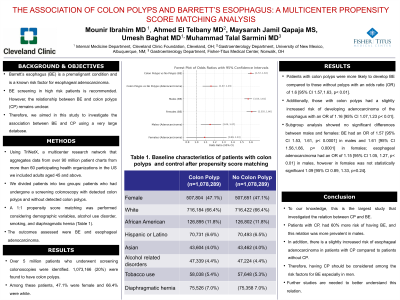Sunday Poster Session
Category: Esophagus
P0496 - The Association of Colon Polyps and Barrett's Esophagus: A Multicenter Propensity Score Matching Analysis
Sunday, October 27, 2024
3:30 PM - 7:00 PM ET
Location: Exhibit Hall E

Has Audio

Mounir Ibrahim, MD
Cleveland Clinic Foundation
Holmdel, NJ
Presenting Author(s)
Mounir Ibrahim, MD1, Ahmed El Telbany, MD, MPH2, Maysarah Jamil. Qapaja, MS3, Umesh Baghat, MD4, Muhammad Sarmini, MD5
1Cleveland Clinic Foundation, Holmdel, NJ; 2University of New Mexico, Albuquerque, NM; 3Cairo University School of Medicine, Cairo, Al Jizah, Egypt; 4Cleveland Clinic Foundation, Cleveland, OH; 5Fisher Titus Medical Center, Avon, OH
Introduction: Barrett’s esophagus (BE) is a premalignant condition and is a known risk factor for esophageal adenocarcinoma. BE screening in high risk patients is recommended.
However, the relationship between BE and colon polyps (CP) remains unclear. Therefore, we aimed in this study to investigate the association between BE and CP using a very large database.
Methods: Using TriNetX, a multicenter research network that aggregates data from over 90 million patient charts from more than 60 participating health organizations in the US we included adults aged 45 and above, dividing them into two groups: patients who had undergone a screening colonoscopy with detected colon polyps and patients who had undergone a screening colonoscopy without detected colon polyps. A 1:1 propensity score matching was performed considering demographic variables, alcohol use disorder, smoking, and obesity (Table 1). The outcomes assessed were BE and esophageal adenocarcinoma.
Results: Over 5 million patients who underwent screening colonoscopies were identified. 1,073,166 (20%) were found to have colon polyps. Among these patients, 47% were female and 67% were white. Patients with colon polyps were more likely to develop BE compared to those without polyps with an odds ratio (OR) of 1.6 [95% CI 1.57,1.63, p< 0.0001]. Additionally, those with colon polyps had a slightly increased risk of developing adenocarcinoma of the esophagus with an OR of 1.16 [95% CI 1.07,1.23 p< 0.0004]. Subgroup analysis showed no significant differences between males and females: BE had an OR of 1.57 [95% CI 1.53, 1.61, p< 0.0001] in males and 1.61 [95% CI 1.555,1.66, p< 0.0001] in females; esophageal adenocarcinoma had an OR of 1.15 [95% CI 1.05, 1.27, p< 0.0034] in males, however in females was not statistically significant 1.09 [95% CI 0.89, 1.33, p=0.2386].
Discussion: To our knowledge, this is the largest study that investigated the relation between CP and BE. Patients with CP, had 60% more risk of having BE, and this relation was more prevalent in males. In addition, there is a slightly increased risk of esophageal adenocarcinoma in patients with CP compared to patients without CP.
Therefore, having CP should be considered among the risk factors for BE especially in men. Further studies are needed to better understand this relation.
Note: The table for this abstract can be viewed in the ePoster Gallery section of the ACG 2024 ePoster Site or in The American Journal of Gastroenterology's abstract supplement issue, both of which will be available starting October 27, 2024.
Disclosures:
Mounir Ibrahim, MD1, Ahmed El Telbany, MD, MPH2, Maysarah Jamil. Qapaja, MS3, Umesh Baghat, MD4, Muhammad Sarmini, MD5. P0496 - The Association of Colon Polyps and Barrett's Esophagus: A Multicenter Propensity Score Matching Analysis, ACG 2024 Annual Scientific Meeting Abstracts. Philadelphia, PA: American College of Gastroenterology.
1Cleveland Clinic Foundation, Holmdel, NJ; 2University of New Mexico, Albuquerque, NM; 3Cairo University School of Medicine, Cairo, Al Jizah, Egypt; 4Cleveland Clinic Foundation, Cleveland, OH; 5Fisher Titus Medical Center, Avon, OH
Introduction: Barrett’s esophagus (BE) is a premalignant condition and is a known risk factor for esophageal adenocarcinoma. BE screening in high risk patients is recommended.
However, the relationship between BE and colon polyps (CP) remains unclear. Therefore, we aimed in this study to investigate the association between BE and CP using a very large database.
Methods: Using TriNetX, a multicenter research network that aggregates data from over 90 million patient charts from more than 60 participating health organizations in the US we included adults aged 45 and above, dividing them into two groups: patients who had undergone a screening colonoscopy with detected colon polyps and patients who had undergone a screening colonoscopy without detected colon polyps. A 1:1 propensity score matching was performed considering demographic variables, alcohol use disorder, smoking, and obesity (Table 1). The outcomes assessed were BE and esophageal adenocarcinoma.
Results: Over 5 million patients who underwent screening colonoscopies were identified. 1,073,166 (20%) were found to have colon polyps. Among these patients, 47% were female and 67% were white. Patients with colon polyps were more likely to develop BE compared to those without polyps with an odds ratio (OR) of 1.6 [95% CI 1.57,1.63, p< 0.0001]. Additionally, those with colon polyps had a slightly increased risk of developing adenocarcinoma of the esophagus with an OR of 1.16 [95% CI 1.07,1.23 p< 0.0004]. Subgroup analysis showed no significant differences between males and females: BE had an OR of 1.57 [95% CI 1.53, 1.61, p< 0.0001] in males and 1.61 [95% CI 1.555,1.66, p< 0.0001] in females; esophageal adenocarcinoma had an OR of 1.15 [95% CI 1.05, 1.27, p< 0.0034] in males, however in females was not statistically significant 1.09 [95% CI 0.89, 1.33, p=0.2386].
Discussion: To our knowledge, this is the largest study that investigated the relation between CP and BE. Patients with CP, had 60% more risk of having BE, and this relation was more prevalent in males. In addition, there is a slightly increased risk of esophageal adenocarcinoma in patients with CP compared to patients without CP.
Therefore, having CP should be considered among the risk factors for BE especially in men. Further studies are needed to better understand this relation.
Note: The table for this abstract can be viewed in the ePoster Gallery section of the ACG 2024 ePoster Site or in The American Journal of Gastroenterology's abstract supplement issue, both of which will be available starting October 27, 2024.
Disclosures:
Mounir Ibrahim indicated no relevant financial relationships.
Ahmed El Telbany indicated no relevant financial relationships.
Maysarah Qapaja indicated no relevant financial relationships.
Umesh Baghat indicated no relevant financial relationships.
Muhammad Sarmini indicated no relevant financial relationships.
Mounir Ibrahim, MD1, Ahmed El Telbany, MD, MPH2, Maysarah Jamil. Qapaja, MS3, Umesh Baghat, MD4, Muhammad Sarmini, MD5. P0496 - The Association of Colon Polyps and Barrett's Esophagus: A Multicenter Propensity Score Matching Analysis, ACG 2024 Annual Scientific Meeting Abstracts. Philadelphia, PA: American College of Gastroenterology.
